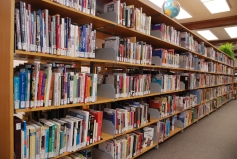
What do you do to help with library organization throughout the school year? If you’re anything like most school librarians, you wear many different hats at your school. In addition to being the library media specialist, you might be in charge of the school website, yearbook, or technology equipment. Maybe you’re the Accelerated Reader coordinator or outdoor sign updater. You’re also a book shelver, book repairer, etc. If you don’t have an assistant, this can lead to a lot of stress and chaos. We’ve come up with a few library organization tips to help keep the stress at a minimum level.
Library Helpers
First, consider "employing" several library helpers each year. At the beginning of the school year, have interested 5th-grade students fill out a library helper application. These students have to be willing to come in one day each week during their recess time or another designated period. Ideally, library helpers would help shelve books, but they don't always do a good job, so you can assign them other small tasks like putting barcode stickers on index cards or delivering AR reports to teachers. Any help you can get is good help.

Library Organization for Books
Second, take a good look at how you organize your shelves. How do you organize your shelves? If a collection hasn’t been properly weeded it can be a mess. Do your shelves have so many books crammed on them that students can’t even look for them? Is it impossible to put books away?
Fiction
It’s probably easiest to organize fiction by the author’s last name, but you might want to choose some special shelves just for series of books (like Dan Gutman's My Weird School, 39 Clues, Nancy Drew, Magic Tree House, etc.) so students can quickly find their favorite collections or find new series to love. You could also consider using a special sticker to identify books in a series or popular chapter books to make them easier for students to find. It might also be helpful to have an easy chapter books section for early readers.
Nonfiction
Have you recently looked at the dates of your nonfiction books? Do you have biographies on people who were famous twenty years ago or a pro basketball collection from 1994?
How do you organize your shelves? One librarian told us a horror story of doing a major overhaul of the library one summer and I had a hard time deciding exactly what to do. That school year was her first at this school and inherited a mess, quite frankly. Her guess is that the library hasn't been properly weeded in her lifetime. The Easy collection had so many books crammed on the shelves that the students couldn't even look for a book. Not to mention, books were impossible to put away. While you want students to look beyond a book, remember that nonfiction covers can also often look dated. You could use special stickers or shelf cards to point out popular topics and recent additions to your library as well.
However you choose to organize, you should set aside a bit of time once or twice a year to really go through your collection and clean, weed, and reorganize so things don’t stay out of order. This is especially true if you use student helpers or volunteers to assist with shelving.
Check-Out Procedures
Next, look at your checkout system. You can create your own library checkout cards for students. It’s okay if they are pretty low-tech. Just get on your Library Management Tool, print out barcodes for each student, and stick them onto different colored index cards. Use a different color for each homeroom and keep them in an index card box right beside the scanner so the students can't lose them. You can have the students decorate their cards at the beginning of the school year so it's easier for them to find their cards in the box. This also helps younger students who may not be able to read their names yet. You could even laminate the cards to help them last a little longer.
When students come in for book checkout, they bring their books to the computer and scan their card, then their books. This takes some practice, and the students don't always do it exactly right, but it will buy you a little bit of time to help students find books if you don't have an assistant.

Student Visitors
It can also help to take a look at when students are allowed to visit your library. For example, if your school has open library time, require students to have a library pass to visit. That way you know their teachers have accounted for them. You can give teachers a set of laminated passes. As long as each teacher only has 2-3 passes you can ensure your library won’t be overrun with students. Click here to download our free printable library pass!
Finally, cut down the time you spend planning lessons. You can take time during the summer to do a bulk of the lesson planning or you can use our library lesson plans and resources to save even more time. Look to websites such as TeachersPayTeachers for other templates and resources as well. It may seem expensive, but the more you have prepared in advance and ready to go, the more time you have to work on keeping your library organized and helping students.
What idea can you share that would help everyone as school starts this year? Do you have any suggestions for ways to improve my shelves? How do you deal with elementary library organization problems? Leave your helpful hints in the comments.
Also, if you're not on our mailing list yet, click here to sign up. There are free resources we send out especially to newsletter subscribers so don't miss out!


This is my second year at this library and I inherited shelves that were organized by ATOS reading levels. For example all the 2.0 book levels are on the same shelf (both fiction/non-fiction). So it's been very frustrating trying to search for books that students or teachers are requesting. They can be anywhere really.
I just wanted to seek your advice on what I should do. Should I do a complete overhaul and organize the way it's meant to be? Fiction by author's last name and non-fiction by dewey decimal system. I know it would be a lot of work and don't even know where to start. Help me please!
I want to say as someone who does not have a library degree, but works in access services at a university library, this is extremely useful. We have a children and young adult section that has not been a priority for a while as it is not the most widely used and not technically the most important section as we are a government depository and a research library first.
While working from home p/t during the COVID-19 pandemic, I am doing some of the research my supervisor and I had discussed me doing maybe a few months ago. This is a wonderful starting point to put together ideas to discuss in a meeting. I want to thank everyone for their contributions, including ideas. They were genuinely fantastic. It even gave me ideas on who I should reach out to at work once I begin to actually formulate ideas.
I'm retired from a public school district, both as an elementary libraian (8 1/2 years )and a district level facilitator (14 years). I have 2 comments.
While genrefication is better in finding books, I believe students need to learn that systems exist to location and access. This is especially true for using public and institutional libraries. With such an emphasis on students attending college, I believe types of systems are important to learn and prepare for.
My second comment is about how we address the previous librarian and as someone mentioned, the "hot mess" left behind. Please consider that while you may have strong feelings about what you are faced with, so did the previous librarian. We all do the best we can with what we have. And you will too. You will try to make the library as welcoming and awesome as you can for the students you serve. You will set your own priorities as will your administrators. Just remember we each chose to be a school librarian with its many hats from year to year. You wouldn't want to see your successor's comments about your "hot mess" when you believed you were doing your best.
Trying to help our PT media specialist reorganize after moving our space. We’re needing to purge and also wanting to make the space as user-friendly and easy as possible! We think we want to organize by genre/topic.
For those who have organized this way, would you please share your categories? Do you separate picture books by theme (realistic fiction/fairytales/math/alphabet) or just keep them in alphabetical order by author in one group? And if a book overlaps 2 categories, do you just make an executive decision? To add to the stress, we’ve got about 3 days and about 6 preteens coming in tomorrow to help! We need a plan!
AR stands for Accelerated Reader. These are books the students can read and then take computer based tests on them. Only school libraries have them marked as AR books.